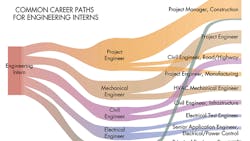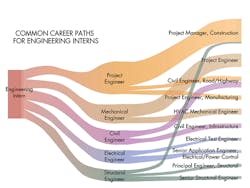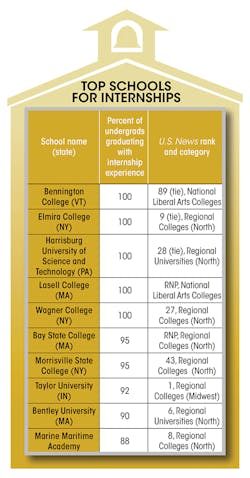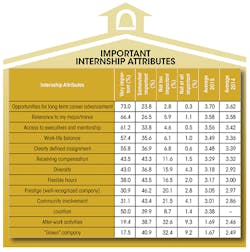Engineering Internships: The Key to Finding a Job
This file type includes high resolution graphics and schematics when applicable.
Engineering majors enjoy some of the highest starting salaries in today’s economy. In 2014, the top three engineering majors in terms of starting salary were petroleum, electrical, and computer engineering, according to the Bureau of Labor Statistics. But what is the key to getting that first job?
An ongoing trend is that most engineers obtain jobs through internships—temporary positions emphasizing on-the-job training rather than just employment. It is the difference between doing menial tasks and learning a new skill set. In 2012, the National Association of Colleges and Employers showed that almost 80% of employers view internships as a way to find full-time hires. Accordingly, many have turned to increasing their intern pool, thus ensuring a steady supply of trained, proven new recruits.
What Internships Mean to Students
Internships are a gateway for young students coming out of college, enabling them to learn practical skills while also applying what they have learned in the classroom (see "A Checklist for Engineering Interns"). “Universities teach students how to think, but they don’t provide real world experience, so people leave school unprepared for the workplace,” said Ryan Smith, CEO and founder of Qualtrics. In an editorial piece for Fortune, Smith noted that the goal of internships is to provide real world training, or the 3,000 flight hours of real work experience.
Internships also help students match up with the right company prior to entering the job market. The struggle many students find when leaving college is where to apply for a job. Many are unsure of which companies are right for them and many more are grasping at straws for any job willing to take them.
Interns do not have this problem. The current conversion rate from intern to full-time employee is 51.7 % according the 2015 Internship & Co-op Survey conducted by the National Association of Colleges and Employers. A student, who has had more than one summer or full school year of interning has a much clearer sense of whether or not that job is for them. The earlier students start interning (i.e., sophomore year versus junior year), the more companies they can “try out.”
Networking is another major benefit of internships. Professionals use networking as a way of staying up-to-date with the industry and also keeping an eye on future prospects. Internships are an excellent way for students and recent graduates to develop their professional network.
Focusing on the right studies and career goals is a challenge faced by every engineering student. The majors available to engineering can sometimes be very broad. You choose mechanical engineering as a major, but when you apply for a job, you realize you can be a plant engineer, a drafter, a construction supervisor, a plumbing engineer, a technician, etc.
Internships help narrow the focus on a specific career or studies. If you intern at Boeing and decide that aerospace engineering isn’t for you, within mechanical engineering, you can switch your focus to construction or plant engineering. Interning also helps you ascertain your preferred work environment: Do you want to work at a large company with 1,000 employees or more? A small firm with less than 300 employees? Do you prefer a hands-on technician job or a design/drafting desk job? Perhaps an engineering management or research/analysis engineer position? Or would you rather go into contracting for yourself?
In an ideal setting, internships can provide a ton of opportunity. However, not every intern can be so lucky. There are instances when an intern becomes pigeonholed and only performs menial tasks, or “grunt work.” Depending on the attention given by a supervisor, interns can either create powerful networking relationships or be neglected and not be provided with a real learning experience. Expenses also can hinder an internship. Many internships are unpaid either for an interim time, with the promise of a full-time job, or because the students are still in school. If the internship requires travel, the expenses fall upon the intern. This can easily turn an intern experience into a burden.
Another possible disadvantage of an internship is the lack of time and training. Usually internships are for the summer and may only last three to four months. In an engineering firm, the learning curve could be two months before an intern becomes acclimated with the new systems or software used by the firm. Once they have mastered the basics, the intern may only have one month or two left before they leave.
According to Craig Doherty, CEO of Newbotics, the slotted time frame is one of the biggest problems with the internship process today. His organization trains students via internships throughout their four years of college. There, they work on actual projects commissioned by third-party companies at the same time they’re learning about the fundamentals of engineering.
What Internships Mean to Companies
Companies are realizing that engineering graduates lack adequate technical experience. They can understand the physic principles, but lack the basic skills of how to read or create drawings, perform a bolt stackup, or understand and apply industry design standards (such as ASME guidelines).
Current engineering graduates require three to five years of training before they can fully understand the day-to-day practices of a job, said Doherty, adding that they only stay at one company, on average, for two-and-a-half years. This is obviously a problem for companies that want their new employees to hit the ground running.
Since companies want people who can start working and producing right away, internships are their main source. As an intern, companies can train and invest into you. They will instruct interns on their policies and practices. Interns will learn specific skills that are particular to the company. For example, drawing techniques and 3D CAD skills differ from company to company. Even though the basic principles of 3D modeling are the same across major CAD programs like CATIA or SolidWorks, each program has its own unique methodology. Interns can learn these programs prior to full-time employment.
This idea of growing your engineering talent also applies to relationships. Engineering projects can take several years to complete and having a guaranteed work force coming every few years ensures the project will always be staffed. Companies should be placing their interns in long-term projects in an effort to train them on that project for when they return.
Investing in interns also helps the other problem of the engineering work force; age and retirement. According to Machine Design’s Salary Survey, the average age for engineers is 51. This means that in 15 years’ time, many will retire. This presents two distinct problems. The first is that the workforce will decrease and engineering companies will be looking for employees.
The other problem that arises is the lack of training for young engineers. Engineering companies typically pair up young engineers with senior engineers to help them learn the ins and outs of that particular industry. This will happen at the beginning of an engineer’s employment. However, if the process can occur earlier, you start to bridge the age gap.
While interns will bridge the workforce gap, it is a plan that needs to be developed. Having interns is an investment and, as such, will cost time and money. Companies must be willing to both pay interns and use some of their current employers time to properly train their interns. The upfront cost of training could potentially yield benefits in the shape of future employees.
However, companies must accept that interns-to-employees are not a guarantee. Many companies enlist a work requirement when an employee has their education paid for by said company. This is not the case with interns. They are currently free to pursue other job prospects that differ from the intern company.
The Current State of Internships
Internships offer young students their first real look at the working world, and the face of internships is changing. Some companies are now looking at high school students to populate their intern pool instead of just college students. Conexus Indiana has paired 80 high school students with engineering companies to provide them with manufacturing internships. The students work fulltime for six weeks and are paid $9 per hour.
The science, technology, engineering, and mathematics (STEM) movement is also looking to push companies into the classroom to encourage students to pursue STEM degrees. The National Academy Foundation held a panel event in June 2015, comprised of industry leaders like Hewlett-Packard and Qualcomm, to discuss how to engage more students in STEM. The panel discussed that one of the biggest problems in pursuing a STEM degree was that young students could not picture a future in STEM or felt unprepared for it.
The panelists also discussed how many employers were concerned about a mismatch between graduates’ skill level and future work responsibilities. To help push STEM education, companies are holding work learning experiences either in the classroom or places of business. Ed Hidalgo, senior director of staffing at Qualcomm, said hands-on training is more useful than internships.
This file type includes high resolution graphics and schematics when applicable.
These hands on training are being labeled as “experienceships” where students can visit a company several times throughout the year and gain in person experience. For example, RoboRAVE, a company that sat on the panel, holds a robotics competition that spans nine countries and involves more than 1,500 students. Also Hewlett-Packard as paired its company leaders with different schools and, with the help from the National Academy Foundation, create a relationship between schools, their students, and companies.





